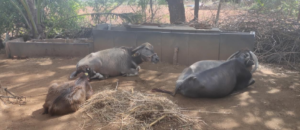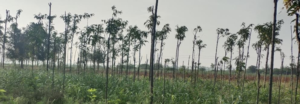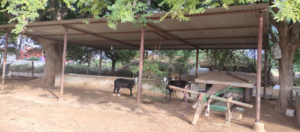A Case study on native Cattle and Buffalo production systems in rural part of Chitradurga district of Karnataka
Kanaka K K1, Nidhi Sukhija1*, Vidhyasagar2, Chethan Raj3
1ICAR-National Dairy Research Institute, Karnal-132001, Haryana, India
2Veterinary College Bidar, KVAFSU, Karnataka
3ICAR-Indian Veterinary Research Institute, Izatnagar
*Corresponding author mail ID: nidhisukhija5@gmail.com
Breeds in the locality
Registered Cattle breeds in Chitradurga district include Amrithmahal and Hallikar, crossbred cattle consist of HF cross and Jersey crosses. Buffalo breed include Dharwari and Surti crosses (with Non-Descript or Dharwadi) and Murrah crosses (with Non-Descript or Dharwadi).
Productivity
Amrithmahal: Famous draught breed known for its power and endurance. Animals are fiery and active. Bullocks are especially suited for trotting and quick transportation. These animals are reared in extensive management system. They produce average of 570 to 600 kg milk per lactation.
Hallikar: Best draught breed of Southern India. Most of the South Indian breeds have originated from this breed. Management mostly include Semi intensive to extensive systems. They yield average of 540 to 560 kg milk per lactation.
Crossbred cattle: HF and Jersey crossbreds are reared in semi-intensive to intensive production system as a milch animals. HF crossbred in this arid region produces 3000 to 4000 kg of milk per lactation while Jersey crossbred yield 2500 to 3000 kg of milk per lactation. Since Jersey adopt well in hot tropical areas like in Chitradurga they are the preferred crossbreds of choice.
Buffalos
Buffalo maintained here yield about 3 to 5 litre milk per day. And in one lactation 1400 to 1600 litres of milk can be expected. The major drawbacks in buffalo production in the locality is long age at first calving (AFC) i.e., around 4 years and long Service period (around 10 months to 1 year). In recent times due to selective breeding and subsequent artificial insemination less productive buffalos are upgrading.

Fig. 1: Buffaloes are tied to manger in an open space under tree shadow
Feeds and Fodder:
Chitradurga district is a semi-arid tropical region with annual rainfall varies between 457mm to 668mm. Most crops are grown in rainy season whose residues can be used as fodder and under irrigation only crops of economic importance are grown in all seasons. As the advent of dairying some of the farmers are growing fodder maize, fodder jower and Napier gross. Some of the important fodder/agriculture residues used to feed dairy animals are as follows.

Fig. 2: Napier and Sesbania grown together in a field.
- 1. Maize: Agricultural by-product of maize is mainly used to feed the animals. It is grown only on monsoon. And are stored as a heap (Banave in local language). However some farmers are growing fodder purpose maize under irrigation throughout the year. Typical inclusion levels maize fodder ranges from 50 to 70 %.
- 2.Jower: Second important crop which is grown after maize. Typically grown in monsoons. In recent years they are not using as a food source in humans ration and hence now a days only grown for fodder purpose throughout the year under irrigation.
3.Peanut / Groundnut residues: It is the main source of fodder to animals during late winter to end of summer. It is grown during monsoon and processing will starts in mid- winter hence their residues available as fodder source from late winter. Their inclusion level ranges from 50 to 70 % in animal diet.
4.Ragi straw: Ragi is the important ration in human diet in this region. Grown during all seasons under irrigation system. Their straws are fed to animals throughout the year since it can be stored for long terms and it doesn’t get mould infection easily (my observation). Inclusion level 30 to 50%
5.Napier grass: This grass is only produced by the farmers maintaining crossbred animals. Grown throughout the year under irrigation system. They fed as green fresh fodder.
6.Paddy straw: In last decade it was also a one of the main fodder for the animals. But due to drought and government scheme (“Anna Bhagya” – 7 kg of rice provided per human head per month) farmers in this locality left the practice of growing paddy (my observation).
Other fodder produced include Lucerne and Sesbania (which usually fed to sheep and Goats under Intensive production system). Along with these fodders crossbred rearing farmers provide 2 to 3 kg of protein concentrate (Available as 22%, 24% protein concentrate in 50kg bags) and 2 to 3 kg of energy concentrates (mainly maize flour) to their animals.
Housing:
Typical animal sheds in this locality are of kutcha house type with bare earth as floor and thatched roof with one side covering. However, since last decade they are upgrading to pucca houses with natural stone slabs and concrete as floor material and asbestos / steel sheets as roof material. Under MNREGA (Mahatma Gandhi National rural Employment Guarantee Act) subsidies are giving to farmers for constructing animal houses which is impacting the upgradation of animal sheds. Typically, sheds are constructed for 3 to 4 livestock units though the average animals holding size is 2 to 3 livestock unit, keeping in mind of future expansion. Buffaloes and indigenous cattle are tied in open areas under tree shades both during day period and only during nights they are tied in sheds. Generally, feed is fed in the mangers and for drinking water farmers will take to open tanks. But for crossbred animals both feed and water are provided in the shed itself.

Fig. 3: A shed constructed with asbestos sheets as roof and concrete floor.
Milk marketing:
There is a huge demand for Buffalo and Indigenous cattle milk in the locality which is evident as recent start of marketing Indigenous animal milk and Buffalo milk by the KMF (Karnataka Milk Federation). The local vendors sell Buffalo milk for 50 to 60/- INR per litre and Indigenous cattle milk up to 40 to 50/- INR per litre. Beside this Milk Cooperative Societies (MPCs) are setting in village clusters (2 to 3 villages per cluster) which is encouraging people to produce more milk. In this locality SHIMUL (Shivamogga, Davanagere, Chitradurga Milk Union Limited), a branch of KMF is collecting milk from the farmers. Pricing is mainly done by fat percent. A litre of milk with 4% of fat and 9% of SNP is fetching 28/- INR (However due to marketing problems faced by KMF due to COVID-19 pandemics temporarily milk rate per litre starts from 23/- INR.). Government of Karnataka is encouraging farmers to produce more milk by providing incentives of INR 6/- per litre of milk poured to KMF.


